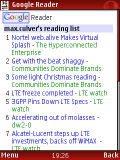
It must have been 10 years ago when I first heard that soon we will be able to pay with our mobile phone at vending machines in train stations and other places. However, until today I've never seen it anywhere. And now this: In the Austrian countryside I've seen the vending machine shown in the picture on the left where you can actually pay with your (Austrian) mobile phone and if you are subscribed to paybox.at.
It works as follows: You send an SMS with the code of the vending machine to the SMS number shown on the vending machine. After a couple of seconds, the machine displays our paybox balance that you can then use to get that candy bar, soft drink or cigarette pack. Nice, simple and works with every phone.
What I haven't quite figured out yet is how much the service costs per transaction. I've had a look at the paybox web site but I couldn't find anything. The yearly subscription is 19 euros, which I think is a bit high for mass market adoption. But there are other applications as well such as money transfers, paying for parking in major cities and paying for high way tools.
The paybox website also mentions that when having a post paid mobile subscription with one of the major Austrian network operators, the paybox yearly subscription fee is already inclusive. In that case no registration seems to be required and that candy bar is yours without any additional steps to be taken before using it the first time. A very beneficial cooperation for both paybox and the mobile network operators. I wonder how paybox managed to bring them all into the boat!?
Also, this means that paybox enabled vending machines must be connected to the Internet, or some sort of Intranet. So I guess there are some synergy effects, such as the vending machine being able to report when it runs out of candy bars so it is only serviced when it is really necessary. I wonder how the vending machine is connected. GPRS maybe?

